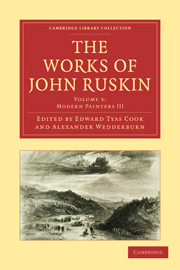Book contents
- Frontmatter
- Contents
- LIST OF ILLUSTRATIONS
- INTRODUCTION TO THIS VOLUME
- BIBLIOGRAPHICAL NOTE
- Modern Painters, VOL. III. (CONTAINING THE TEXT OF ALL THE EDITIONS)
- PREFACE
- PART IV “OF MANY THINGS”
- CHAP. I OF THE RECEIVED OPINIONS TOUCHING THE “GRAND STYLE”
- CHAP. II OF REALIZATION
- CHAP. III OF THE REAL NATURE OF GREATNESS OF STYLE
- CHAP. IV OF THE FALSE IDEAL:—FIRST, RELIGIOUS
- CHAP. V OF THE FALSE IDEAL:—SECONDLY, PROFANE
- CHAP. VI OF THE TRUE IDEAL:—FIRST, PURIST
- CHAP. VII OF THE TRUE IDEAL:—SECONDLY, NATURALIST
- CHAP. VIII OF THE TRUE IDEAL:—THIRDLY, GROTESQUE
- CHAP. IX OF FINISH
- CHAP. X OF THE USE OF PICTURES
- CHAP. XI OF THE NOVELTY OF LANDSCAPE
- CHAP. XII OF THE PATHETIC FALLACY
- CHAP. XIII OF CLASSICAL LANDSCAPE
- CHAP. XIV OF MEDIÆVAL LANDSCAPE:—FIRST, THE FIELDS
- CHAP. XV OF MEDIÆVAL LANDSCAPE:—SECONDLY, THE ROCKS
- CHAP. XVI OF MODERN LANDSCAPE
- CHAP. XVII THE MORAL OF LANDSCAPE
- CHAP. XVIII OF THE TEACHERS OF TURNER
- APPENDIX
- Plate section
CHAP. VII - OF THE TRUE IDEAL:—SECONDLY, NATURALIST
Published online by Cambridge University Press: 05 November 2011
- Frontmatter
- Contents
- LIST OF ILLUSTRATIONS
- INTRODUCTION TO THIS VOLUME
- BIBLIOGRAPHICAL NOTE
- Modern Painters, VOL. III. (CONTAINING THE TEXT OF ALL THE EDITIONS)
- PREFACE
- PART IV “OF MANY THINGS”
- CHAP. I OF THE RECEIVED OPINIONS TOUCHING THE “GRAND STYLE”
- CHAP. II OF REALIZATION
- CHAP. III OF THE REAL NATURE OF GREATNESS OF STYLE
- CHAP. IV OF THE FALSE IDEAL:—FIRST, RELIGIOUS
- CHAP. V OF THE FALSE IDEAL:—SECONDLY, PROFANE
- CHAP. VI OF THE TRUE IDEAL:—FIRST, PURIST
- CHAP. VII OF THE TRUE IDEAL:—SECONDLY, NATURALIST
- CHAP. VIII OF THE TRUE IDEAL:—THIRDLY, GROTESQUE
- CHAP. IX OF FINISH
- CHAP. X OF THE USE OF PICTURES
- CHAP. XI OF THE NOVELTY OF LANDSCAPE
- CHAP. XII OF THE PATHETIC FALLACY
- CHAP. XIII OF CLASSICAL LANDSCAPE
- CHAP. XIV OF MEDIÆVAL LANDSCAPE:—FIRST, THE FIELDS
- CHAP. XV OF MEDIÆVAL LANDSCAPE:—SECONDLY, THE ROCKS
- CHAP. XVI OF MODERN LANDSCAPE
- CHAP. XVII THE MORAL OF LANDSCAPE
- CHAP. XVIII OF THE TEACHERS OF TURNER
- APPENDIX
- Plate section
Summary
§ 1. We now enter on the consideration of that central and highest branch of ideal art which concerns itself simply with things as they are, and accepts, in all of them, alike the evil and the good. The question is, therefore, how the art which represents things simply as they are, can be called ideal at all. How does it meet that requirement stated in Chap. III. § 24, as imperative on all great art, that it shall be inventive, and a product of the imagination? It meets it pre-eminently by that power of arrangement which I have endeavoured, at great length and with great pains, to define accurately in the chapter on Imagination associative in the second volume. That is to say, accepting the weaknesses, faults, and wrongnesses in all things that it sees, it so places and harmonizes them that they form a noble whole, in which the imperfection of each several part is not only harmless, but absolutely essential, and yet in which whatever is good in each several part shall be completely displayed.
§ 2. This operation of true idealism holds, from the least things to the greatest. For instance, in the arrangement of the smallest masses of colour, the false idealist, or even the purist, depends upon perfecting each separate hue, and raises them all, as far as he can, into costly brilliancy; but the naturalist takes the coarsest and feeblest colours of the things around him, and so interweaves and opposes them that they become more lovely than if they had all been bright.
- Type
- Chapter
- Information
- The Works of John Ruskin , pp. 111 - 129Publisher: Cambridge University PressPrint publication year: 2010First published in: 1904

